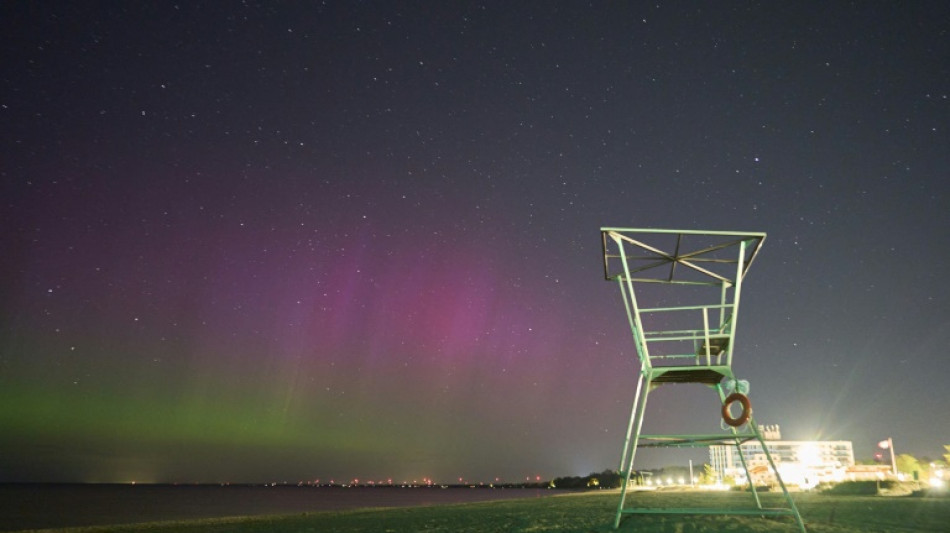
-
 Emirates orders 65 more Boeing 777X planes despite delays
Emirates orders 65 more Boeing 777X planes despite delays
-
Ex-champion Joshua to fight YouTube star Jake Paul

-
 Bangladesh court sentences ex-PM to be hanged for crimes against humanity
Bangladesh court sentences ex-PM to be hanged for crimes against humanity
-
Trade tensions force EU to cut 2026 eurozone growth forecast

-
 'Killed without knowing why': Sudanese exiles relive Darfur's past
'Killed without knowing why': Sudanese exiles relive Darfur's past
-
Stocks lower on uncertainty over tech rally, US rates

-
 Death toll from Indonesia landslides rises to 18
Death toll from Indonesia landslides rises to 18
-
Macron, Zelensky sign accord for Ukraine to buy French fighter jets

-
 India Delhi car bomb accused appears in court
India Delhi car bomb accused appears in court
-
Bangladesh ex-PM sentenced to be hanged for crimes against humanity

-
 Leftist, far-right candidates advance to Chilean presidential run-off
Leftist, far-right candidates advance to Chilean presidential run-off
-
Bangladesh's Hasina: from PM to crimes against humanity convict

-
 Rugby chiefs unveil 'watershed' Nations Championship
Rugby chiefs unveil 'watershed' Nations Championship
-
EU predicts less eurozone 2026 growth due to trade tensions

-
 Swiss growth suffered from US tariffs in Q3: data
Swiss growth suffered from US tariffs in Q3: data
-
Bangladesh ex-PM sentenced to death for crimes against humanity

-
 Singapore jails 'attention seeking' Australian over Ariana Grande incident
Singapore jails 'attention seeking' Australian over Ariana Grande incident
-
Tom Cruise receives honorary Oscar for illustrious career

-
 Fury in China over Japan PM's Taiwan comments
Fury in China over Japan PM's Taiwan comments
-
Carbon capture promoters turn up in numbers at COP30: NGO

-
 Japan-China spat over Taiwan comments sinks tourism stocks
Japan-China spat over Taiwan comments sinks tourism stocks
-
No Wemby, no Castle, no problem as NBA Spurs rip Kings

-
 In reversal, Trump supports House vote to release Epstein files
In reversal, Trump supports House vote to release Epstein files
-
Gauff-led holders USA to face Spain, Argentina at United Cup

-
 Ecuador voters reject return of US military bases
Ecuador voters reject return of US military bases
-
Bodyline and Bradman to Botham and Stokes: five great Ashes series

-
 Iran girls kick down social barriers with karate
Iran girls kick down social barriers with karate
-
Asian markets struggle as fears build over tech rally, US rates

-
 Australia's 'Dad's Army' ready to show experience counts in Ashes
Australia's 'Dad's Army' ready to show experience counts in Ashes
-
UN Security Council set to vote on international force for Gaza

-
 Japan-China spat sinks tourism stocks
Japan-China spat sinks tourism stocks
-
Ecuador voters set to reject return of US military bases

-
 Trump signals possible US talks with Venezuela's Maduro
Trump signals possible US talks with Venezuela's Maduro
-
Australian Paralympics gold medallist Greco dies aged 28

-
 Leftist, far-right candidates go through to Chilean presidential run-off
Leftist, far-right candidates go through to Chilean presidential run-off
-
Zelensky in Paris to seek air defence help for Ukraine

-
 Bangladesh verdict due in ex-PM's crimes against humanity trial
Bangladesh verdict due in ex-PM's crimes against humanity trial
-
A pragmatic communist and a far-right leader: Chile's presidential finalists

-
 England ready for World Cup after perfect campaign
England ready for World Cup after perfect campaign
-
Cervical cancer vaccine push has saved 1.4 million lives: Gavi

-
 World champion Liu wins Skate America women's crown
World champion Liu wins Skate America women's crown
-
Leftist leads Chile presidential poll, faces run-off against far right

-
 Haaland's Norway thump sorry Italy to reach first World Cup since 1998
Haaland's Norway thump sorry Italy to reach first World Cup since 1998
-
Portugal, Norway book spots at 2026 World Cup

-
 Sinner hails 'amazing' ATP Finals triumph over Alcaraz
Sinner hails 'amazing' ATP Finals triumph over Alcaraz
-
UK govt defends plan to limit refugee status

-
 Haaland's Norway thump Italy to qualify for first World Cup since 1998
Haaland's Norway thump Italy to qualify for first World Cup since 1998
-
Sweden's Grant captures LPGA Annika title

-
 Tuchel lays down law to Bellingham after England star's frustration
Tuchel lays down law to Bellingham after England star's frustration
-
Sinner caps eventful year with ATP Finals triumph over great rival Alcaraz


Dazzling auroras fade from skies as sunspot turns away
The spectacular auroras that danced across the sky in many parts of the world over the weekend are fading, scientists said Monday, as the massive sunspot that caused them turns its ferocious gaze away from Earth.
Since Friday, the most powerful solar storm to strike our planet in more than two decades has lit up night skies with dazzling auroras in the United States, Tasmania, the Bahamas and other places far from the extreme latitudes where they are normally seen.
But Eric Lagadec, an astrophysicist at France's Observatoire de la Cote d'Azur, told AFP that the "most spectacular" period of this rare event has come to an end.
The first of several coronal mass ejections (CMEs) -- expulsions of plasma and magnetic fields from the Sun -- came just after 1600 GMT Friday, according to the US-based National Oceanic and Atmospheric Administration (NOAA).
The event was later upgraded to an "extreme" geomagnetic storm -- the first since the "Halloween Storms" of October 2003 that caused blackouts in Sweden and damaged power infrastructure in South Africa.
Excitement over the phenomenon -- and otherworldly photos of pink, green and purple night skies -- broke out across the world, from Austria to Australia's island state of Tasmania.
The storm had been forecast to intensify again until 0600 GMT Monday, the NOAA said, adding that auroras could be viewable as far south as New York.
But thousands of people who came out on Sunday night in the hope of seeing the aurora borealis over the Joshua Tree National Park in California instead saw the Milky Way. AFP pictures showed stars shining clearly in the night sky.
- 'Monster sunspot' -
Lagadec said that while there were further solar outbursts on Sunday, it is unlikely that more auroras will be visible to the naked eye in lower latitudes such as in France.
"Only the most experienced photographers will be able to capture them" in such areas, said Lagadec, who was moved by witnessing an aurora during the event's peak on Friday night.
The solar storm emanated from a massive sunspot cluster that is 17 times wider than our planet.
The storm has not ended, and auroras are expected to continue in the far northern or southern regions where they are normally visible.
But "the source of the storm is a sunspot that is now on the edge of the Sun, (so) we do not expect the next coronal mass ejections to head in Earth's direction," Lagadec said.
Scientists had already warned that the intensity of anything seen on Sunday night would unlikely reach the level of Friday's show.
"This is likely the last of the Earth-directed CMEs from this particular monster sunspot," Mathew Owens, a professor of space physics at the UK's University of Reading, told AFP.
When charged particles from solar winds are captured by Earth's magnetic field, they accelerate towards the planet's magnetic poles, which is why auroras are normally seen there.
But during periods of heightened solar activity, the effects extend farther toward the equator.
- Satellites weathered storm -
Unlike during 2003's solar storms, no major disruptions to power or communications networks appear to have been reported this time around.
Elon Musk's satellite internet operator Starlink said on X that its thousands of satellites in low Earth orbit had "weathered the geomagnetic storm and remain healthy".
Unlike solar flares, which travel at the speed of light and reach Earth in around eight minutes, CMEs travel at a more sedate pace, with officials putting the current average at 800 kilometers (500 miles) per second.
People with eclipse glasses can still look for the sunspot cluster during the day.
Fluctuating magnetic fields associated with geomagnetic storms induce currents in long wires, including power lines, which can lead to blackouts. Long pipelines can also become electrified.
Spacecraft are at risk from high doses of radiation, although the atmosphere prevents this from reaching Earth.
Even pigeons and other species that have internal biological compasses can be affected.
H.Jarrar--SF-PST




